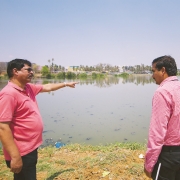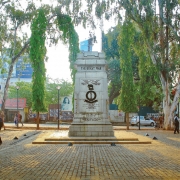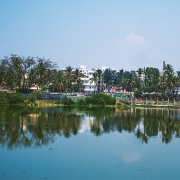
People

Wing Commander (retd) G B Athri, Bengaluru’s one-man army, uses the RTI Act to restore his beloved city to its former glory, writes Chitra Ramaswamy
The pelicans are back at Bengaluru’s Madiwala Lake, and they are not the only happy campers. Anglers are having a field day on the lake’s shores, and walkers and joggers have returned for their daily dose of fresh air.
It was impossible to imagine a scenario like this until just two years ago as the lake, one of Bengaluru’s biggest, had been pronounced ‘dead’ owing to high toxicity. It has since been resuscitated, thanks to a hard-fought battle, with Wing Commander (retd) G B Athri on the frontlines. Wait a minute, did someone just say ‘battle’? You see, the retired Indian Air Force officer loves a hearty battle, and when it comes to taking on corrupt government agencies and even pharma giant Biocon to salvage a piece of his beloved city, it’s all-out war. Using the powerful Right to Information (RTI) Act, Athri has been helping revive Bengaluru’s water bodies, restoring dignity to Army veterans and taking up cudgels on behalf of nomads, for the past six years.
It all started when Athri returned to Bengaluru in 2001, after serving for 25 years in the Indian Air Force. After retirement, he worked in the BPO industry and then with the Indian Institute of Management, Bengaluru. As he adjusted to civilian life, the crusader in him began to stir. Athri had taken up residence in Saraswathipuram, and he succeeded in getting the local authorities to give his new neighbourhood a massive facelift. By 2011, Saraswathipuram not only had impeccable infrastructure, it had changed into a green and welcoming neighbourhood. Athri had found his calling—he wanted to be a change-maker.
One of the first steps he took was to study the RTI Act; as soon as he got a handle on it, he started connecting it with issues and challenges he noticed all over the city. That’s how the retired Wing Commander began his relentless crusade against defaulters, miscreants, and anyone on the wrong side of the law.
One of his biggest victories is the rejuvenation of Madiwala Lake and its two neighbouring lakes, Arakere and Hulimavu, located in the middle of Bengaluru. Madiwala, the size of 110 football fields, had already been declared ‘dead’ by environmental studies but Athri used the RTI Act to find out which agencies
were responsible for its maintenance.
He made a shocking discovery. The reply to his RTI application revealed that untreated sewage from neighbouring apartments and residences, mainly the BTM Layout that borders one side of the lake, was contaminating the water bodies—a lapse on the part of as many as five civic agencies. First, Athri lodged a complaint with the Karnataka State Pollution Control Board (KSPCB), but the main culprit was the Bengaluru Water Supply and Sewerage Board (BWSSB). “Most city lakes have died because of the apathy of the sewerage board,” he points out. “When they knew the city was growing, they did not take measures to tackle wastewater. Instead, they have been directing sewage through the storm-water drains, into the lakes! So instead of rainwater alone entering the drains and then flowing into the lakes, raw sewage is getting into the storm-water drains and finding its way to the lakes.”
Athri’s relentless effort to bring the guilty to book resulted in the Pollution Control Board filing criminal charges under the Water (Prevention and Control of Pollution) Act, 1974, against the top brass of the Sewerage Board, including its then chairperson. This was a first of its kind. “As many as 13 officials were charged for allowing the lakes to become polluted,” he reveals. “Although all of them are out on bail, I am happy to have played a role in making this happen.”
Madiwala is finally witnessing a rejuvenation following a year-long battle and the formation of a Lake Watchdog Committee (LWC), which comprises local government agencies and citizens’ representatives. Its waters are being de-silted and the on-site sewerage treatment plant (STP) has undergone maintenance to ensure that only treated water enters the lake. The slush from the lake was dredged, compacted and used to build a walkway that is now being enjoyed by morning walkers and joggers.
According to Suresh Dharmaji, a member of the LWC, “When I moved to Kamanahalli [near Hulimavu Lake] 10 years ago, we didn’t even know there was a lake here. Apart from construction workers who used the lake to relieve themselves, it had also becoming a dumping ground for the shops nearby. Residents, too, were throwing their garbage into the drains instead of dustbins. When it rains, it is all carried into the lakes.” Karnataka State Information Commissioner L Krishnamurthy is all praise for Athri’s style of functioning. “It is a pleasure to interact with the retired Wing Commander, who has a very disciplined and systematic approach in dealing with issues,” he says. “He uses the RTI Act for public good and gets to the heart of the matter. He then thoroughly researches the subject before approaching the authorities.”
By mid-2015, the dust had barely settled on the Madiwala Lake rejuvenation issue when it was under threat from another quarter. To decongest Bengaluru’s IT corridor, a bypass road connecting Hosur Road to BTM Layout was sanctioned—it was to be constructed on the lake bund. This meant a portion of the lake would have to be reclaimed.
Athri and the LWC went into battle mode and, once again, came to the rescue of Madiwala. “Sure, the IT corridor needed to be decongested and an alternative road was the need of the hour, but not on the lake bund,” says Athri. “We suggested they create an elevated bypass, 15 m away from the bund.” The issue was also brought to the notice of the chief minister and, within months, work on the bypass began away from the bund, at an elevated level, just as Athri had suggested.
Having tackled the authorities in the city, our crusader set his sights on Tunga River, which flows through his hometown of Sringeri, 325 km from Bengaluru. A 2014 RTI application had revealed that Sringeri, which produces over 9 million litre of household effluents and sewerage per day, did not have even a basic STP in place. The famed Sringeri Mutt, located on the riverbank, was adding to the pollution by disposing its solid kitchen waste into the waterway. “It took almost two years but by early 2016, STPs were set up to take care of effluents that flowed into the river,” says Athri. “A compact, manure-making machine has also been installed in the mutt premises and the solid kitchen waste generated by it is turned into manure, which is being used as fertiliser in the mutt garden.”
Athri’s most triumphant battle to date, though, has been the one with biotechnology giant Biocon, whose biopharmaceutical factory was discharging untreated arsenic and lead into Hebbagodi Lake on the outskirts of Bengaluru. Demonstrations and protests by residents’ welfare associations and NGOs against the company as far back as in 2001 had yielded no results.
Using the RTI Act, Athri gathered information on the various consents and permissions given to Biocon, how and why these were issued, and the several show-cause notices issued to them by the Pollution Control Board. Paradoxically, he found they also had the necessary consent to continue their work! Athri questioned these inconsistencies and, in September 2014, lodged a voluminous written complaint with the board. He wanted to know why it had not taken action against Biocon under the Environment Protection Act and even demanded that the company be shut down!
The voice of reason hit home. By June 2015, Biocon’s Chairman and Managing Director Kiran Mazumdar-Shaw agreed to meet with Athri.
This set the ball rolling and Biocon agreed to clean up its mess. Work on rejuvenating Hebbagodi Lake began in May 2016. First, boats rounded up the sludge and collected surface plastic. Water hyacinths and other invasive weeds were similarly taken out. More important, the industrial effluents being discharged by Biocon’s manufacturing facility are now passed through an STP before being released into the lake.
Lately, aquatic creatures have begun visiting the lake, a sign that the water body is making a speedy recovery. Fish have started breeding, ducks have been spotted, birds have begun showing up and water snakes are now flourishing. J Hiremath, a fellow activist, is all praise for Athri’s courage. “Being an activist myself, I often seek his advice on matters like this. Imagine what it must have taken to get Biocon to rejuvenate Hebbagodi as redemption for the contamination they caused!”
Lourde Raj Joseph, vice-president and head of central engineering and EHS at Biocon, gives Athri due credit: “Wing Commander G B Athri is immensely committed to restoring the lost glory of Bengaluru and we are pleased to engage with him in the restoration of Hebbagodi Lake. He has been playing a significant role in enabling the lake revival plan.”
With so much to juggle, you’d think our crusader would have his hands full. Not this Wing Commander, who set his heart on a cause close to his heart. He found that a 98 year-old war memorial, built as a tribute to Indian soldiers who lost their lives in World War I, was being defaced with, of all things, a public toilet. It had been set up by the Bengaluru Metropolitan Transport Corporation for the convenience of its drivers and conductors. For a retired Air Force officer, this was sacrilege! “Tell me, which country disgraces its soldiers like this?” asks Athri, who took up the cause in 2015. Needless to say, the toilets are gone and the memorial has since been transformed into a place for people to relax and enjoy the sights in Bengaluru’s city centre.
Indeed, for a crusader like Athri, the war is never over. He is still waiting for the results of an RTI application he had filed back in 2012 seeking information on government land allotted for the construction of 250 homes for nomads in Uttarahalli, under the Ashraya Housing Scheme. Surprisingly, the files have gone missing! “I filed an RTI request in 2012. Nothing has come of it so far. But I will persist. If at least 500 people can get subsidised housing out of this project, my efforts will be worth it.”
So, in Athri’s opinion, what ails this nation? “We have a law for everything but implementation has always been our greatest problem,” he responds. “The bureaucracy, which is responsible for enforcing the law, must pay attention to the needs and concerns of society. Unless we perceive the common man as important, things will not improve.”
VANISHING LAKES
Bengaluru, the City of Lakes, got its moniker from a centuries-old water and irrigation system set up by the city’s founders. The lakes, most of them manmade, were connected by a large network of canals that channelled surplus water to the lakes downstream. But owing to the rapid urbanisation of Bengaluru since the IT boom of the 1970s, records show the following:
- Bengaluru had 285 lakes in the ’70s; today, there are 194 lakes, most of them sewage-fed
- The Bengaluru Water Supply and Sewarage Board has the capacity to treat half the sewage generated; the rest flows into the lakes, untreated
- Lakebeds have been encroached upon for apartments, malls and other unauthorised development projects
- As the city expanded, the canals connecting the lakes were filled up, causing flooding during the monsoon.
Titled Wetlands: Treasure of Bangalore (Abused, Polluted, Encroached & Vanishing), a study published last year by a team of researchers, headed by Professor T V Ramachandran of the Centre for Ecological Science, IISC, Bengaluru, has made the following observations:
- Four of the 105 lakes surveyed in Bengaluru were in good condition
- 90 per cent of the lakes are fed untreated sewage, industrial effluents, solid waste, building debris and even biomedical waste
- Lack of coordination among the civic and state agencies administering the lakes contributes to their neglect
- There has been a 925-per-cent increase in urban areas across four decades (1973-2013).
Photos: Sumukh Bharadwaj, Arpita Vishwanath Featured in Harmony — Celebrate Age Magazine May 2017
you may also like to read
-
For the love of Sanskrit
During her 60s, if you had told Sushila A that she would be securing a doctorate in Sanskrit in the….
-
Style sensation
Meet Instagram star Moon Lin Cocking a snook at ageism, this nonagenarian Taiwanese woman is slaying street fashion like….
-
Beauty and her beast
Meet Instagram star Linda Rodin Most beauty and style influencers on Instagram hope to launch their beauty line someday…..
-
Cooking up a storm!
Meet Instagram star Shanthi Ramachandran In today’s web-fuelled world, you can now get recipes for your favourite dishes at….










